What is the best base for a small greenhouse?
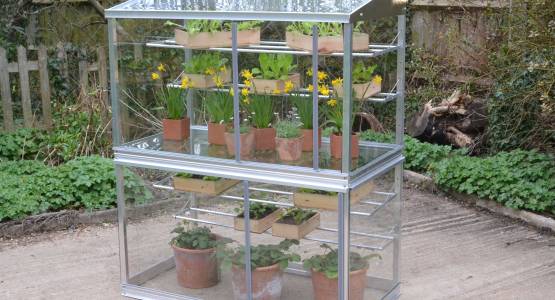
What is the Best Base for a Small Greenhouse?
A greenhouse can be an incredible addition to your garden, enabling you to extend growing seasons, protect delicate plants, and cultivate a wide variety of flora in a controlled environment. However, the foundation of your greenhouse—its base—is arguably one of the most important elements of the entire structure. Selecting the right base ensures stability, durability, and optimal performance, setting the stage for a thriving greenhouse environment. In this blog, we will explore the best options for a small greenhouse base, taking into account factors like cost, ease of installation, and suitability for different environments.
Why is the Greenhouse Base Important?
The base of a greenhouse serves several key purposes:
- Structural Stability: A sturdy base keeps your greenhouse secure, especially during strong winds or heavy rain.
- Level Foundation: A level base ensures proper alignment of the greenhouse frame and panels, preventing issues like leaks or uneven stress.
- Drainage: A well-designed base promotes proper water drainage, reducing the risk of waterlogging or flooding inside the greenhouse.
- Thermal Insulation: The base can help insulate the greenhouse, as soil filled timber base or a concrete base absorb heat during the day and give the warmth back off in the evening.
Now that we understand the importance of a greenhouse base, let’s dive into the best materials and construction options for a small greenhouse.
Best Base Options for a Small Greenhouse
1. Concrete Slab
A concrete slab is one of the most durable and long-lasting bases for a small greenhouse. It provides a solid and level surface, making it ideal for areas with extreme weather conditions.
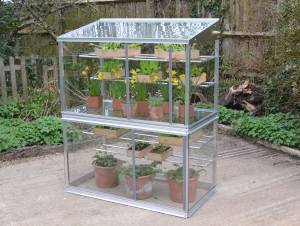
Advantages:
- Durability: Concrete can withstand heavy loads and harsh weather conditions.
- Easy to Clean: A concrete surface is simple to clean and maintain, reducing the risk of pests and disease.
- Versatile: Suitable for permanent greenhouse installations.
Disadvantages:
- Cost: Concrete is one of the more expensive options.
- Drainage: Without proper planning, a solid concrete slab can cause water pooling.
- Permanent: Once installed, it’s challenging to modify or remove.
Installation Tips:
- Include drainage channels or install the slab at a slight angle to prevent water build-up.
- Pea gravel can be added to the base of the greenhouse to prevent contact with the damp concrete.
- Use a vapor barrier beneath the slab to reduce moisture seepage.
2. Gravel Base
Gravel bases are a popular choice for small greenhouses due to their affordability and ease of installation. This option is particularly suited for temporary or semi-permanent structures.
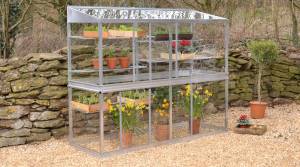
Advantages:
- Cost-Effective: Gravel is inexpensive and readily available.
- Good Drainage: Allows water to drain naturally, preventing waterlogging.
- Flexibility: Easy to remove or modify if needed.
Disadvantages:
- Weed Growth: Without a weed barrier, grass or weeds may grow through the gravel.
- Shifting: Over time, gravel may shift and require re-levelling.
- Fixing: It is more difficult to fix the greenhouse down. Metal or wood pegs may be needed to secure taller greenhouses and prevent them from blowing over in high winds.
Installation Tips:
- Lay a geotextile fabric beneath the gravel to prevent weed growth.
- Use a tamper to compact the earth under the membrane and then the gravel to ensure a level surface.
- Opt for pea gravel or crushed stone for better stability.
3. Timber Base
A timber base, often constructed from pressure-treated wood, is a practical and attractive option for small greenhouses. It works well in gardens with uneven terrain or where portability is desired.
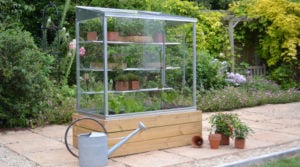
Advantages:
- Affordable: Timber is relatively inexpensive compared to concrete.
- Easy to Install: Requires minimal tools and expertise.
- Aesthetic Appeal: Complements natural surroundings.
- Creates thermal mass: The glass will warm the greenhouse in the daytime and this heat will be absorbed by the soil. In the evening this heat will be given back off, extending the growing day.
Disadvantages:
- Durability: Wood is prone to rot and decay without proper treatment.
- Maintenance: Regular sealing or staining is required to prolong its lifespan.
Installation Tips:
- Use pressure-treated or rot-resistant wood like cedar or redwood.
- Elevate the timber base slightly off the ground to prevent water damage.
- Secure the timber frame to the ground with stakes or anchors for added stability.
- On taller greenhouses, secure the greenhouse to the wooden base.
4. Paving Slabs
Paving slabs are another excellent choice for a greenhouse base, combining durability with good drainage.
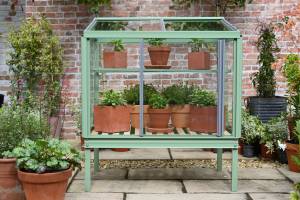
Advantages:
- Durable: Resistant to wear and tear.
- Easy to Clean: Smooth surfaces are simple to sweep or hose down.
- Good Drainage: Spaces between slabs allow excess water to drain.
Disadvantages:
- Labour-Intensive: Installation requires effort to level the slabs properly.
- Cost: High-quality paving materials can be expensive.
Installation Tips:
- Lay the slabs on a compacted sand or gravel bed for stability.
- Leave small gaps between slabs for improved drainage.
- Use a spirit level to ensure an even surface.
5. Dirt or Grass Base
For a truly budget-friendly option, you can place a small greenhouse directly on dirt or grass. This approach is best for lightweight or temporary greenhouses and cold frames.
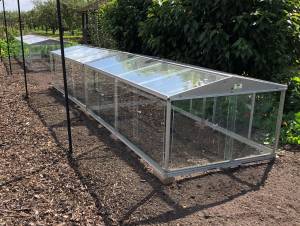
Advantages:
- Low Cost: No additional materials are required.
- Natural Drainage: The soil naturally absorbs excess water.
- Easy Setup: Minimal preparation is needed.
Disadvantages:
- Instability: Uneven ground can lead to shifting or sagging.
- Pest Issues: Direct contact with soil increases the risk of pests.
- Mud: Rain can make the interior muddy and unpleasant and can also splash onto the glass.
Installation Tips:
- Level the ground as much as possible before setting up the greenhouse.
- Add a layer of mulch or gravel inside the greenhouse to improve footing and reduce mud.
- Consider anchoring the structure to prevent shifting in strong winds.
Key Factors to Consider When Choosing a Greenhouse Base
1. Budget
Your budget will significantly influence your choice of base. Gravel and dirt are the most affordable options, while concrete and paving slabs require a larger investment.
2. Climate
For areas with heavy rainfall or strong winds, a solid base like concrete or paving slabs offers superior stability. In drier climates, gravel or timber may suffice.
3. Permanence
If your greenhouse is intended as a permanent feature, consider durable options like concrete or paving slabs. For temporary or movable greenhouses, gravel or timber bases are more practical.
4. Drainage
Proper drainage is crucial to prevent waterlogging and maintain plant health. Ensure that your chosen base promotes effective water runoff.
5. Ease of Installation
DIY enthusiasts may prefer simpler options like gravel or timber, while more complex bases like concrete slabs might require professional assistance.
Greenhouse Base Conclusions
As we have seen, when asking the question What is the Best Base for a Small Greenhouse?, the best base for a small greenhouse depends on your specific needs, including budget, location, and intended use. For a long-lasting and durable solution, a concrete slab or paving slabs are excellent choices. If you’re looking for affordability and flexibility, gravel or a timber frame might be more suitable. For temporary setups, a dirt or grass base can work, though it comes with certain limitations.
By carefully evaluating your options and considering factors like drainage, stability, and climate, you can create a strong foundation for your greenhouse. A well-chosen base will not only enhance the lifespan of your greenhouse but also provide an optimal environment for your plants to thrive.
